Atten Babler Corn & Soybeans FX Indices – Jul…
Corn FX Indices:
The Atten Babler Commodities Corn Foreign Exchange (FX) Indices continued to remain near record high levels during Jun ’16. The USD/Corn Exporter FX Index increased to the fourth highest figure on record while the USD/Corn Importer FX Index and USD/Domestic Corn Importer FX Index each declined throughout the month but remained at the second highest figures on record.
Global Corn Net Trade:
Major net corn exporters are led by the U.S., followed by Brazil, Ukraine, Argentina, Russia and India (represented in green in the chart below). Major net corn importers are led by Japan, followed by the EU-28, South Korea, Mexico and Egypt (represented in red in the chart below).
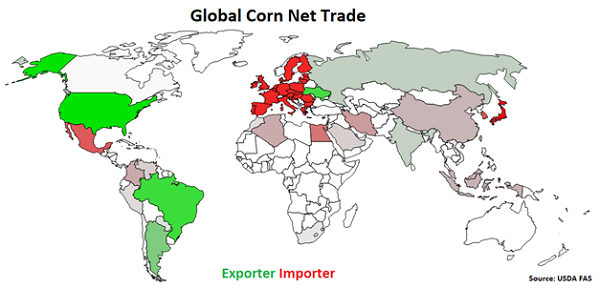 USD/Corn Exporter FX Index:
The USD/Corn Exporter FX Index finished higher for the first time in four months during Jun ’16, increasing 3.5 points to a value of 237.4. The USD/Corn Exporter FX Index finished at the fourth highest figure on record and has increased 156.7 points since the beginning of 2014 and 35.9 points throughout the past six months. A strong USD/Corn Exporter FX Index reduces the competitiveness of U.S. corn relative to other exporting regions (represented in green in the Global Corn Net Trade chart), ultimately resulting in less foreign demand, all other factors being equal. USD appreciation against the Argentine peso has accounted for the majority of the gains since the beginning of 2014.
USD/Corn Exporter FX Index:
The USD/Corn Exporter FX Index finished higher for the first time in four months during Jun ’16, increasing 3.5 points to a value of 237.4. The USD/Corn Exporter FX Index finished at the fourth highest figure on record and has increased 156.7 points since the beginning of 2014 and 35.9 points throughout the past six months. A strong USD/Corn Exporter FX Index reduces the competitiveness of U.S. corn relative to other exporting regions (represented in green in the Global Corn Net Trade chart), ultimately resulting in less foreign demand, all other factors being equal. USD appreciation against the Argentine peso has accounted for the majority of the gains since the beginning of 2014.
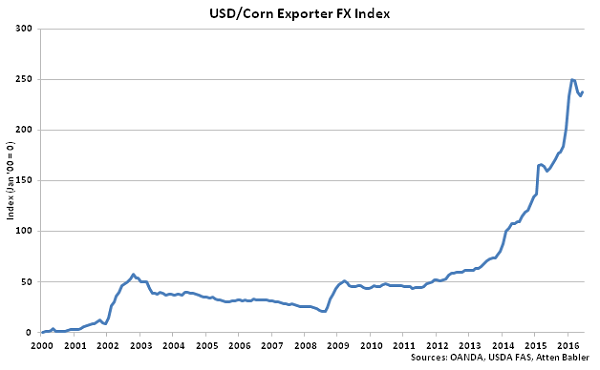 USD appreciation within the USD/Corn Exporter FX Index during Jun ’16 was led by gains against the Argentine peso, followed by USD appreciation against the Serbian dinar. USD declines were exhibited against the Ukrainian hryvnia and Brazilian real.
USD appreciation within the USD/Corn Exporter FX Index during Jun ’16 was led by gains against the Argentine peso, followed by USD appreciation against the Serbian dinar. USD declines were exhibited against the Ukrainian hryvnia and Brazilian real.
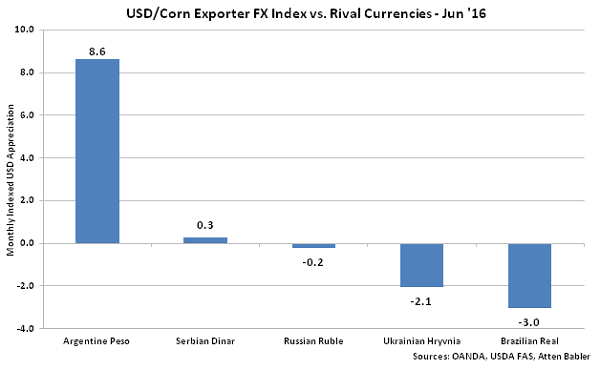 USD/Corn Importer FX Index:
The USD/Corn Importer FX Index declined 1.6 points during Jun ’16, finishing at a value of 145.9. The USD/Corn Importer FX Index remains at the second highest figure on record and has increased 49.2 points since the beginning of 2014 and 18.9 points throughout the past six months. A strong USD/Corn Importer FX Index results in less purchasing power for major corn importing countries (represented in red in the Global Corn Net Trade chart), making U.S. corn more expensive to import. USD appreciation against the Iranian rial and Venezuelan bolivar has accounted for the majority of the gains since the beginning of 2014.
USD/Corn Importer FX Index:
The USD/Corn Importer FX Index declined 1.6 points during Jun ’16, finishing at a value of 145.9. The USD/Corn Importer FX Index remains at the second highest figure on record and has increased 49.2 points since the beginning of 2014 and 18.9 points throughout the past six months. A strong USD/Corn Importer FX Index results in less purchasing power for major corn importing countries (represented in red in the Global Corn Net Trade chart), making U.S. corn more expensive to import. USD appreciation against the Iranian rial and Venezuelan bolivar has accounted for the majority of the gains since the beginning of 2014.
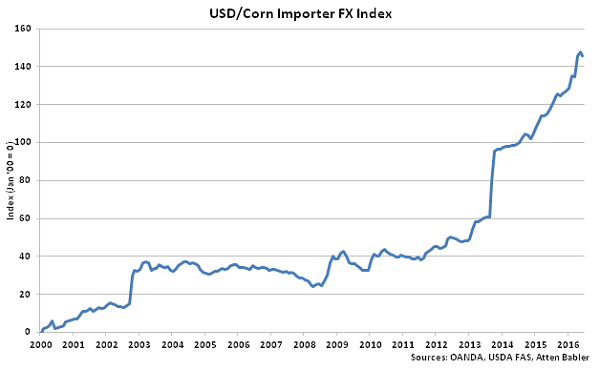 Appreciation against the USD within the USD/Corn Importer FX Index during Jun ’16 was led by gains by the Japanese yen, followed by gains by the Iranian rial and South Korean won. USD appreciation was exhibited against the euro and Mexican peso.
Appreciation against the USD within the USD/Corn Importer FX Index during Jun ’16 was led by gains by the Japanese yen, followed by gains by the Iranian rial and South Korean won. USD appreciation was exhibited against the euro and Mexican peso.
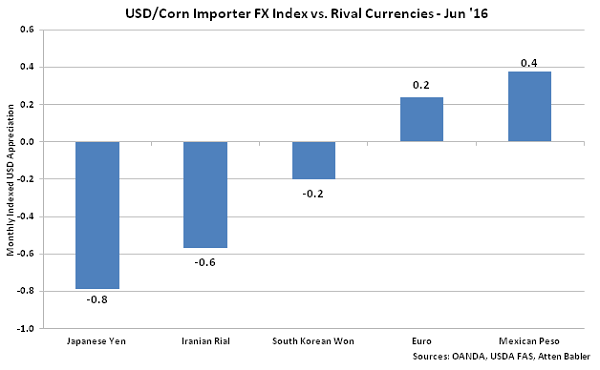 U.S. Corn Export Destinations:
Major destinations for U.S. corn are led by Japan, followed by Mexico, South Korea, Columbia, Egypt and China.
U.S. Corn Export Destinations:
Major destinations for U.S. corn are led by Japan, followed by Mexico, South Korea, Columbia, Egypt and China.
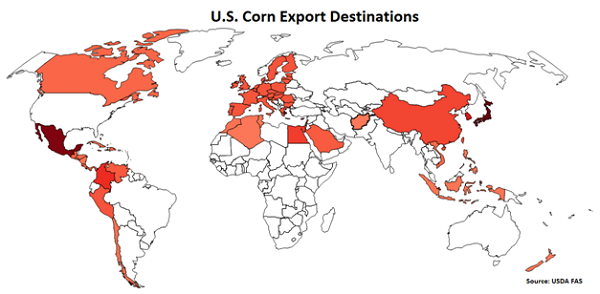 USD/Domestic Corn Importer FX Index:
The USD/Domestic Corn Importer FX Index declined 1.3 points during Jun ’16, finishing at a value of 66.8. The USD/Domestic Corn Importer FX Index remains at the second highest figure on record and has increased 36.3 points since the beginning of 2014 and 18.2 points throughout the past six months. A strong USD/Domestic Corn Importer FX Index results in less purchasing power for the traditional buyers of U.S. corn (represented in red in the U.S. Corn Export Destinations chart), ultimately resulting in less foreign demand, all other factors being equal. USD appreciation against the Mexican peso and Venezuelan bolivar has accounted for the majority of the gains since the beginning of 2014.
USD/Domestic Corn Importer FX Index:
The USD/Domestic Corn Importer FX Index declined 1.3 points during Jun ’16, finishing at a value of 66.8. The USD/Domestic Corn Importer FX Index remains at the second highest figure on record and has increased 36.3 points since the beginning of 2014 and 18.2 points throughout the past six months. A strong USD/Domestic Corn Importer FX Index results in less purchasing power for the traditional buyers of U.S. corn (represented in red in the U.S. Corn Export Destinations chart), ultimately resulting in less foreign demand, all other factors being equal. USD appreciation against the Mexican peso and Venezuelan bolivar has accounted for the majority of the gains since the beginning of 2014.
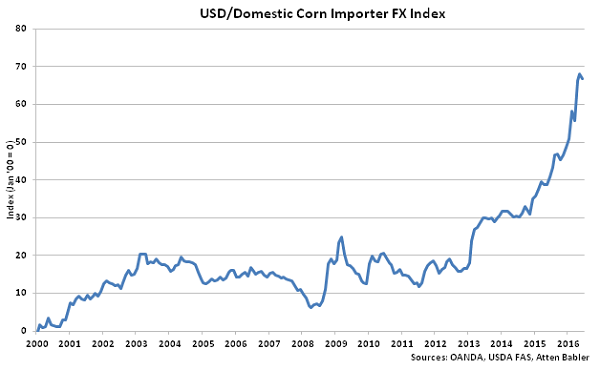 Appreciation against the USD within the USD/Domestic Corn Importer FX Index during Jun ’16 was led by gains by the Japanese yen, followed by gains by the Columbian peso, South Korean won and Peruvian nuevo sol. USD appreciation was exhibited against the Mexican peso.
Appreciation against the USD within the USD/Domestic Corn Importer FX Index during Jun ’16 was led by gains by the Japanese yen, followed by gains by the Columbian peso, South Korean won and Peruvian nuevo sol. USD appreciation was exhibited against the Mexican peso.
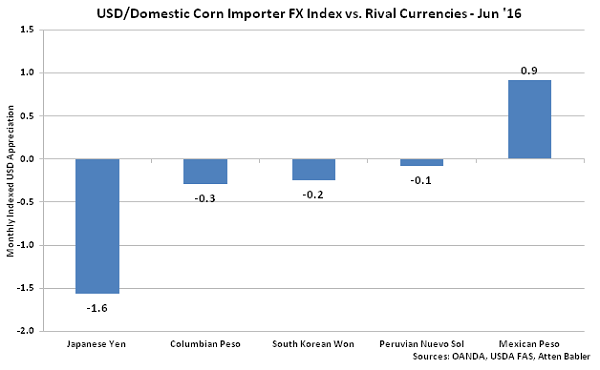 Soybeans FX Indices:
The Atten Babler Commodities Soybeans Foreign Exchange (FX) Indices also continued to remain near recently experienced highs during Jun ’16. The USD/Soybeans Exporter FX Index declined for the fourth consecutive month but remained at the sixth highest figure on record while the USD/Soybeans Importer FX Index and USD/Domestic Soybeans Importer FX Index each increased to levels near recently experienced highs throughout the month.
Global Soybeans Net Trade:
Major net soybeans exporters are led by Brazil, followed by the U.S., Argentina, Paraguay and Uruguay (represented in green in the chart below). Major net soybeans importers are led by China, followed by the EU-28, Mexico, Japan and Taiwan (represented in red in the chart below).
Soybeans FX Indices:
The Atten Babler Commodities Soybeans Foreign Exchange (FX) Indices also continued to remain near recently experienced highs during Jun ’16. The USD/Soybeans Exporter FX Index declined for the fourth consecutive month but remained at the sixth highest figure on record while the USD/Soybeans Importer FX Index and USD/Domestic Soybeans Importer FX Index each increased to levels near recently experienced highs throughout the month.
Global Soybeans Net Trade:
Major net soybeans exporters are led by Brazil, followed by the U.S., Argentina, Paraguay and Uruguay (represented in green in the chart below). Major net soybeans importers are led by China, followed by the EU-28, Mexico, Japan and Taiwan (represented in red in the chart below).
 USD/Soybeans Exporter FX Index:
The USD/Soybeans Exporter FX Index finished lower for the fourth consecutive month during Jun ’16, declining 1.4 points to a value of 139.3. The USD/Soybeans Exporter FX Index remained at the sixth highest figure on record and has increased 86.8 points since the beginning of 2014 and 12.3 points throughout the past six months. A strong USD/Soybeans Exporter FX Index reduces the competitiveness of U.S. soybeans relative to other exporting regions (represented in green in the Global Soybeans Net Trade chart), ultimately resulting in less foreign demand, all other factors being equal. USD appreciation against the Argentine peso has accounted for the majority of the gains since the beginning of 2014.
USD/Soybeans Exporter FX Index:
The USD/Soybeans Exporter FX Index finished lower for the fourth consecutive month during Jun ’16, declining 1.4 points to a value of 139.3. The USD/Soybeans Exporter FX Index remained at the sixth highest figure on record and has increased 86.8 points since the beginning of 2014 and 12.3 points throughout the past six months. A strong USD/Soybeans Exporter FX Index reduces the competitiveness of U.S. soybeans relative to other exporting regions (represented in green in the Global Soybeans Net Trade chart), ultimately resulting in less foreign demand, all other factors being equal. USD appreciation against the Argentine peso has accounted for the majority of the gains since the beginning of 2014.
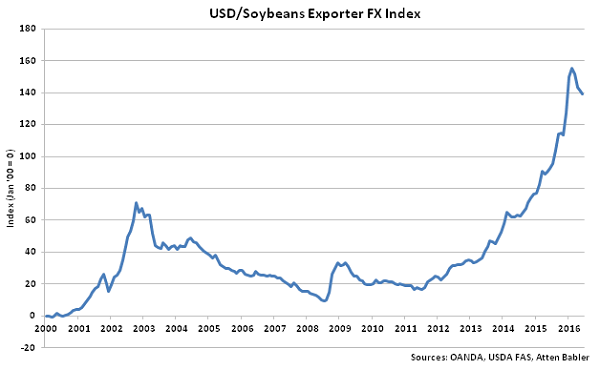 Appreciation against the USD within the USD/Soybeans Exporter FX Index during Jun ’16 was led by gains by the Brazilian real, followed by gains by the Paraguayan guarani. USD appreciation was exhibited against the Canadian dollar and Argentine peso.
Appreciation against the USD within the USD/Soybeans Exporter FX Index during Jun ’16 was led by gains by the Brazilian real, followed by gains by the Paraguayan guarani. USD appreciation was exhibited against the Canadian dollar and Argentine peso.
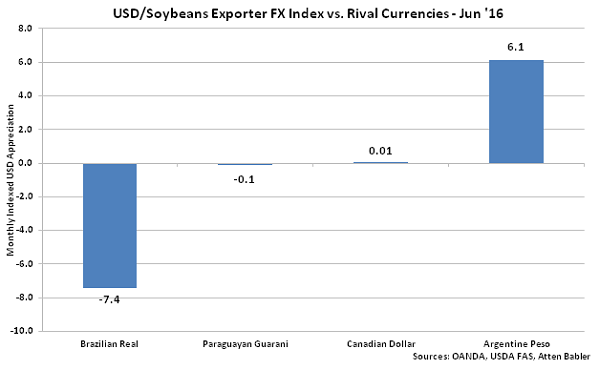 USD/Soybeans Importer FX Index:
The USD/Soybeans Importer FX Index increased 0.7 points during Jun ’16, finishing at a value of 2.3. The USD/Soybeans Importer FX Index has increased 14.5 points since the beginning of 2014 and 1.0 points throughout the past six months. A strong USD/Soybeans Importer FX Index results in less purchasing power for major soybeans importing countries (represented in red in the Global Soybeans Net Trade chart), making U.S. soybeans more expensive to import. USD appreciation against the Chinese yuan renminbi, Turkish lira and euro has accounted for the majority of the gains since the beginning of 2014.
USD/Soybeans Importer FX Index:
The USD/Soybeans Importer FX Index increased 0.7 points during Jun ’16, finishing at a value of 2.3. The USD/Soybeans Importer FX Index has increased 14.5 points since the beginning of 2014 and 1.0 points throughout the past six months. A strong USD/Soybeans Importer FX Index results in less purchasing power for major soybeans importing countries (represented in red in the Global Soybeans Net Trade chart), making U.S. soybeans more expensive to import. USD appreciation against the Chinese yuan renminbi, Turkish lira and euro has accounted for the majority of the gains since the beginning of 2014.
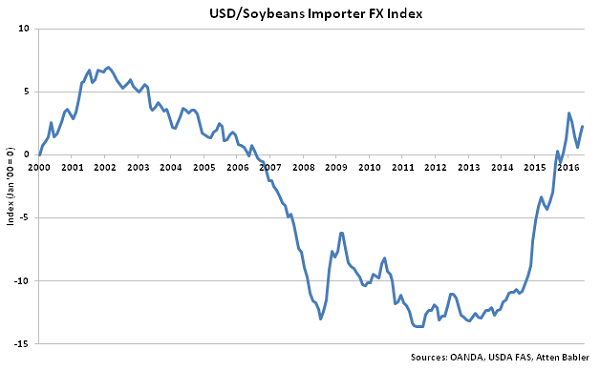 USD appreciation within the USD/Soybeans Importer FX Index during Jun ’16 was led by gains against the Chinese yuan renminbi, followed by gains against the euro and Mexican peso. USD declines were exhibited against the Turkish lira and Japanese yen.
USD appreciation within the USD/Soybeans Importer FX Index during Jun ’16 was led by gains against the Chinese yuan renminbi, followed by gains against the euro and Mexican peso. USD declines were exhibited against the Turkish lira and Japanese yen.
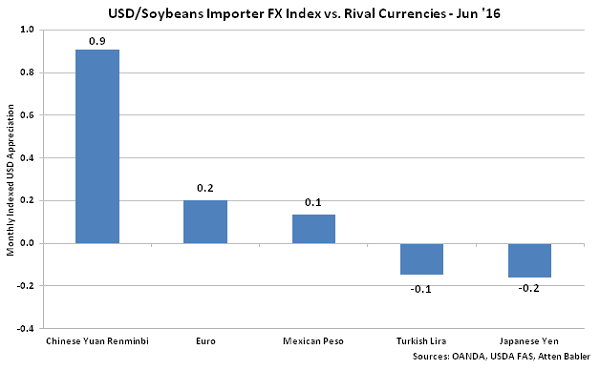 U.S. Soybeans Export Destinations:
Major destinations for U.S. soybeans are led by China, followed by Mexico, Indonesia, Japan, Germany and Taiwan.
U.S. Soybeans Export Destinations:
Major destinations for U.S. soybeans are led by China, followed by Mexico, Indonesia, Japan, Germany and Taiwan.
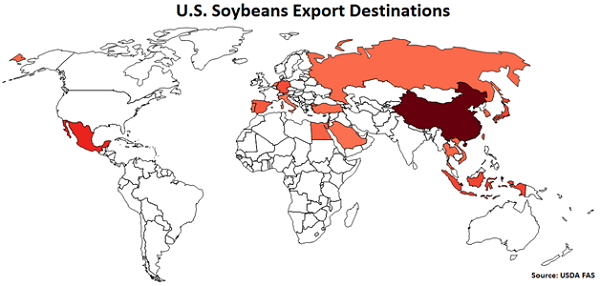 USD/Domestic Soybeans Importer FX Index:
The USD/Domestic Soybeans Importer FX Index increased 0.6 points during Jun ’16, finishing at a value of 4.9. The USD/Domestic Soybeans Importer FX Index has increased 14.7 points since the beginning of 2014 and 1.3 points throughout the past six months. A strong USD/Domestic Soybeans Importer FX Index results in less purchasing power for the traditional buyers of U.S. soybeans (represented in red in the U.S. Soybeans Export Destinations chart), ultimately resulting in less foreign demand, all other factors being equal. USD appreciation against the Mexican peso and Chinese yuan renminbi has accounted for the majority of the gains since the beginning of 2014.
USD/Domestic Soybeans Importer FX Index:
The USD/Domestic Soybeans Importer FX Index increased 0.6 points during Jun ’16, finishing at a value of 4.9. The USD/Domestic Soybeans Importer FX Index has increased 14.7 points since the beginning of 2014 and 1.3 points throughout the past six months. A strong USD/Domestic Soybeans Importer FX Index results in less purchasing power for the traditional buyers of U.S. soybeans (represented in red in the U.S. Soybeans Export Destinations chart), ultimately resulting in less foreign demand, all other factors being equal. USD appreciation against the Mexican peso and Chinese yuan renminbi has accounted for the majority of the gains since the beginning of 2014.
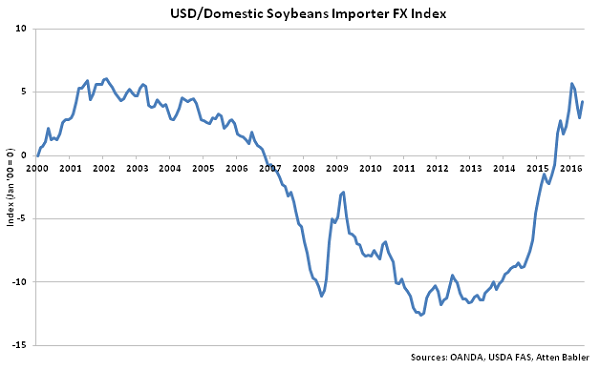 USD appreciation within the USD/Domestic Soybeans Importer FX Index during Jun ’16 was led by gains against the Chinese yuan renminbi, followed by gains against the Mexican peso and euro. USD declines were exhibited against the Indonesian rupiah and Japanese yen.
USD appreciation within the USD/Domestic Soybeans Importer FX Index during Jun ’16 was led by gains against the Chinese yuan renminbi, followed by gains against the Mexican peso and euro. USD declines were exhibited against the Indonesian rupiah and Japanese yen.
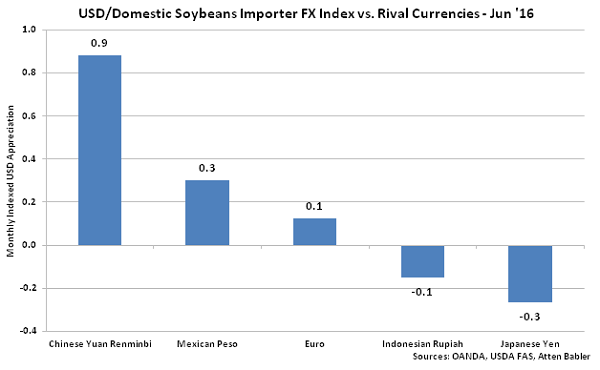
 USD/Corn Exporter FX Index:
The USD/Corn Exporter FX Index finished higher for the first time in four months during Jun ’16, increasing 3.5 points to a value of 237.4. The USD/Corn Exporter FX Index finished at the fourth highest figure on record and has increased 156.7 points since the beginning of 2014 and 35.9 points throughout the past six months. A strong USD/Corn Exporter FX Index reduces the competitiveness of U.S. corn relative to other exporting regions (represented in green in the Global Corn Net Trade chart), ultimately resulting in less foreign demand, all other factors being equal. USD appreciation against the Argentine peso has accounted for the majority of the gains since the beginning of 2014.
USD/Corn Exporter FX Index:
The USD/Corn Exporter FX Index finished higher for the first time in four months during Jun ’16, increasing 3.5 points to a value of 237.4. The USD/Corn Exporter FX Index finished at the fourth highest figure on record and has increased 156.7 points since the beginning of 2014 and 35.9 points throughout the past six months. A strong USD/Corn Exporter FX Index reduces the competitiveness of U.S. corn relative to other exporting regions (represented in green in the Global Corn Net Trade chart), ultimately resulting in less foreign demand, all other factors being equal. USD appreciation against the Argentine peso has accounted for the majority of the gains since the beginning of 2014.
 USD appreciation within the USD/Corn Exporter FX Index during Jun ’16 was led by gains against the Argentine peso, followed by USD appreciation against the Serbian dinar. USD declines were exhibited against the Ukrainian hryvnia and Brazilian real.
USD appreciation within the USD/Corn Exporter FX Index during Jun ’16 was led by gains against the Argentine peso, followed by USD appreciation against the Serbian dinar. USD declines were exhibited against the Ukrainian hryvnia and Brazilian real.
 USD/Corn Importer FX Index:
The USD/Corn Importer FX Index declined 1.6 points during Jun ’16, finishing at a value of 145.9. The USD/Corn Importer FX Index remains at the second highest figure on record and has increased 49.2 points since the beginning of 2014 and 18.9 points throughout the past six months. A strong USD/Corn Importer FX Index results in less purchasing power for major corn importing countries (represented in red in the Global Corn Net Trade chart), making U.S. corn more expensive to import. USD appreciation against the Iranian rial and Venezuelan bolivar has accounted for the majority of the gains since the beginning of 2014.
USD/Corn Importer FX Index:
The USD/Corn Importer FX Index declined 1.6 points during Jun ’16, finishing at a value of 145.9. The USD/Corn Importer FX Index remains at the second highest figure on record and has increased 49.2 points since the beginning of 2014 and 18.9 points throughout the past six months. A strong USD/Corn Importer FX Index results in less purchasing power for major corn importing countries (represented in red in the Global Corn Net Trade chart), making U.S. corn more expensive to import. USD appreciation against the Iranian rial and Venezuelan bolivar has accounted for the majority of the gains since the beginning of 2014.
 Appreciation against the USD within the USD/Corn Importer FX Index during Jun ’16 was led by gains by the Japanese yen, followed by gains by the Iranian rial and South Korean won. USD appreciation was exhibited against the euro and Mexican peso.
Appreciation against the USD within the USD/Corn Importer FX Index during Jun ’16 was led by gains by the Japanese yen, followed by gains by the Iranian rial and South Korean won. USD appreciation was exhibited against the euro and Mexican peso.
 U.S. Corn Export Destinations:
Major destinations for U.S. corn are led by Japan, followed by Mexico, South Korea, Columbia, Egypt and China.
U.S. Corn Export Destinations:
Major destinations for U.S. corn are led by Japan, followed by Mexico, South Korea, Columbia, Egypt and China.
 USD/Domestic Corn Importer FX Index:
The USD/Domestic Corn Importer FX Index declined 1.3 points during Jun ’16, finishing at a value of 66.8. The USD/Domestic Corn Importer FX Index remains at the second highest figure on record and has increased 36.3 points since the beginning of 2014 and 18.2 points throughout the past six months. A strong USD/Domestic Corn Importer FX Index results in less purchasing power for the traditional buyers of U.S. corn (represented in red in the U.S. Corn Export Destinations chart), ultimately resulting in less foreign demand, all other factors being equal. USD appreciation against the Mexican peso and Venezuelan bolivar has accounted for the majority of the gains since the beginning of 2014.
USD/Domestic Corn Importer FX Index:
The USD/Domestic Corn Importer FX Index declined 1.3 points during Jun ’16, finishing at a value of 66.8. The USD/Domestic Corn Importer FX Index remains at the second highest figure on record and has increased 36.3 points since the beginning of 2014 and 18.2 points throughout the past six months. A strong USD/Domestic Corn Importer FX Index results in less purchasing power for the traditional buyers of U.S. corn (represented in red in the U.S. Corn Export Destinations chart), ultimately resulting in less foreign demand, all other factors being equal. USD appreciation against the Mexican peso and Venezuelan bolivar has accounted for the majority of the gains since the beginning of 2014.
 Appreciation against the USD within the USD/Domestic Corn Importer FX Index during Jun ’16 was led by gains by the Japanese yen, followed by gains by the Columbian peso, South Korean won and Peruvian nuevo sol. USD appreciation was exhibited against the Mexican peso.
Appreciation against the USD within the USD/Domestic Corn Importer FX Index during Jun ’16 was led by gains by the Japanese yen, followed by gains by the Columbian peso, South Korean won and Peruvian nuevo sol. USD appreciation was exhibited against the Mexican peso.
 Soybeans FX Indices:
The Atten Babler Commodities Soybeans Foreign Exchange (FX) Indices also continued to remain near recently experienced highs during Jun ’16. The USD/Soybeans Exporter FX Index declined for the fourth consecutive month but remained at the sixth highest figure on record while the USD/Soybeans Importer FX Index and USD/Domestic Soybeans Importer FX Index each increased to levels near recently experienced highs throughout the month.
Global Soybeans Net Trade:
Major net soybeans exporters are led by Brazil, followed by the U.S., Argentina, Paraguay and Uruguay (represented in green in the chart below). Major net soybeans importers are led by China, followed by the EU-28, Mexico, Japan and Taiwan (represented in red in the chart below).
Soybeans FX Indices:
The Atten Babler Commodities Soybeans Foreign Exchange (FX) Indices also continued to remain near recently experienced highs during Jun ’16. The USD/Soybeans Exporter FX Index declined for the fourth consecutive month but remained at the sixth highest figure on record while the USD/Soybeans Importer FX Index and USD/Domestic Soybeans Importer FX Index each increased to levels near recently experienced highs throughout the month.
Global Soybeans Net Trade:
Major net soybeans exporters are led by Brazil, followed by the U.S., Argentina, Paraguay and Uruguay (represented in green in the chart below). Major net soybeans importers are led by China, followed by the EU-28, Mexico, Japan and Taiwan (represented in red in the chart below).
 USD/Soybeans Exporter FX Index:
The USD/Soybeans Exporter FX Index finished lower for the fourth consecutive month during Jun ’16, declining 1.4 points to a value of 139.3. The USD/Soybeans Exporter FX Index remained at the sixth highest figure on record and has increased 86.8 points since the beginning of 2014 and 12.3 points throughout the past six months. A strong USD/Soybeans Exporter FX Index reduces the competitiveness of U.S. soybeans relative to other exporting regions (represented in green in the Global Soybeans Net Trade chart), ultimately resulting in less foreign demand, all other factors being equal. USD appreciation against the Argentine peso has accounted for the majority of the gains since the beginning of 2014.
USD/Soybeans Exporter FX Index:
The USD/Soybeans Exporter FX Index finished lower for the fourth consecutive month during Jun ’16, declining 1.4 points to a value of 139.3. The USD/Soybeans Exporter FX Index remained at the sixth highest figure on record and has increased 86.8 points since the beginning of 2014 and 12.3 points throughout the past six months. A strong USD/Soybeans Exporter FX Index reduces the competitiveness of U.S. soybeans relative to other exporting regions (represented in green in the Global Soybeans Net Trade chart), ultimately resulting in less foreign demand, all other factors being equal. USD appreciation against the Argentine peso has accounted for the majority of the gains since the beginning of 2014.
 Appreciation against the USD within the USD/Soybeans Exporter FX Index during Jun ’16 was led by gains by the Brazilian real, followed by gains by the Paraguayan guarani. USD appreciation was exhibited against the Canadian dollar and Argentine peso.
Appreciation against the USD within the USD/Soybeans Exporter FX Index during Jun ’16 was led by gains by the Brazilian real, followed by gains by the Paraguayan guarani. USD appreciation was exhibited against the Canadian dollar and Argentine peso.
 USD/Soybeans Importer FX Index:
The USD/Soybeans Importer FX Index increased 0.7 points during Jun ’16, finishing at a value of 2.3. The USD/Soybeans Importer FX Index has increased 14.5 points since the beginning of 2014 and 1.0 points throughout the past six months. A strong USD/Soybeans Importer FX Index results in less purchasing power for major soybeans importing countries (represented in red in the Global Soybeans Net Trade chart), making U.S. soybeans more expensive to import. USD appreciation against the Chinese yuan renminbi, Turkish lira and euro has accounted for the majority of the gains since the beginning of 2014.
USD/Soybeans Importer FX Index:
The USD/Soybeans Importer FX Index increased 0.7 points during Jun ’16, finishing at a value of 2.3. The USD/Soybeans Importer FX Index has increased 14.5 points since the beginning of 2014 and 1.0 points throughout the past six months. A strong USD/Soybeans Importer FX Index results in less purchasing power for major soybeans importing countries (represented in red in the Global Soybeans Net Trade chart), making U.S. soybeans more expensive to import. USD appreciation against the Chinese yuan renminbi, Turkish lira and euro has accounted for the majority of the gains since the beginning of 2014.
 USD appreciation within the USD/Soybeans Importer FX Index during Jun ’16 was led by gains against the Chinese yuan renminbi, followed by gains against the euro and Mexican peso. USD declines were exhibited against the Turkish lira and Japanese yen.
USD appreciation within the USD/Soybeans Importer FX Index during Jun ’16 was led by gains against the Chinese yuan renminbi, followed by gains against the euro and Mexican peso. USD declines were exhibited against the Turkish lira and Japanese yen.
 U.S. Soybeans Export Destinations:
Major destinations for U.S. soybeans are led by China, followed by Mexico, Indonesia, Japan, Germany and Taiwan.
U.S. Soybeans Export Destinations:
Major destinations for U.S. soybeans are led by China, followed by Mexico, Indonesia, Japan, Germany and Taiwan.
 USD/Domestic Soybeans Importer FX Index:
The USD/Domestic Soybeans Importer FX Index increased 0.6 points during Jun ’16, finishing at a value of 4.9. The USD/Domestic Soybeans Importer FX Index has increased 14.7 points since the beginning of 2014 and 1.3 points throughout the past six months. A strong USD/Domestic Soybeans Importer FX Index results in less purchasing power for the traditional buyers of U.S. soybeans (represented in red in the U.S. Soybeans Export Destinations chart), ultimately resulting in less foreign demand, all other factors being equal. USD appreciation against the Mexican peso and Chinese yuan renminbi has accounted for the majority of the gains since the beginning of 2014.
USD/Domestic Soybeans Importer FX Index:
The USD/Domestic Soybeans Importer FX Index increased 0.6 points during Jun ’16, finishing at a value of 4.9. The USD/Domestic Soybeans Importer FX Index has increased 14.7 points since the beginning of 2014 and 1.3 points throughout the past six months. A strong USD/Domestic Soybeans Importer FX Index results in less purchasing power for the traditional buyers of U.S. soybeans (represented in red in the U.S. Soybeans Export Destinations chart), ultimately resulting in less foreign demand, all other factors being equal. USD appreciation against the Mexican peso and Chinese yuan renminbi has accounted for the majority of the gains since the beginning of 2014.
 USD appreciation within the USD/Domestic Soybeans Importer FX Index during Jun ’16 was led by gains against the Chinese yuan renminbi, followed by gains against the Mexican peso and euro. USD declines were exhibited against the Indonesian rupiah and Japanese yen.
USD appreciation within the USD/Domestic Soybeans Importer FX Index during Jun ’16 was led by gains against the Chinese yuan renminbi, followed by gains against the Mexican peso and euro. USD declines were exhibited against the Indonesian rupiah and Japanese yen.
